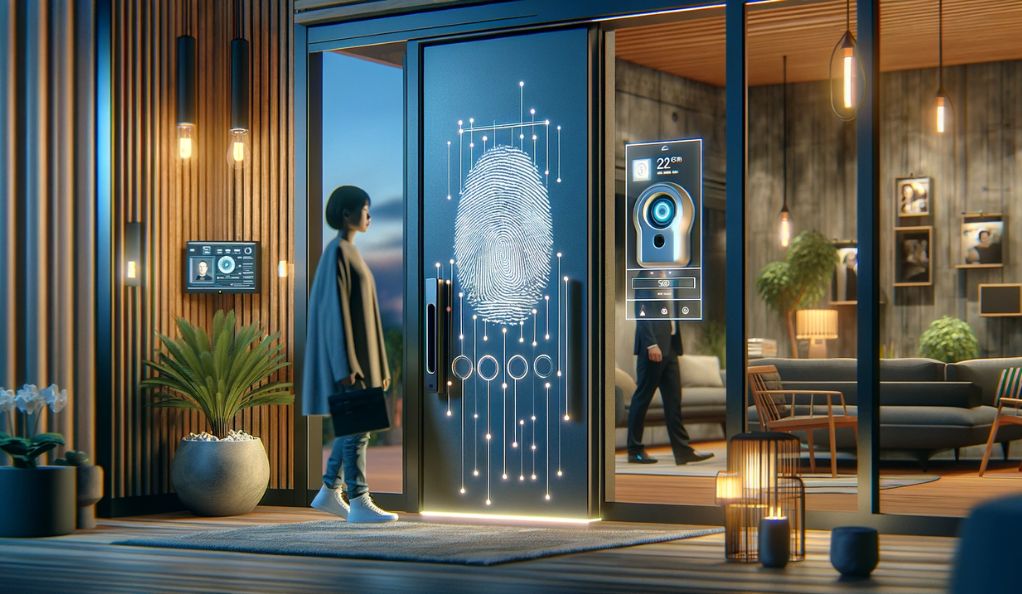In today’s rapidly evolving security landscape, the integration of physical and digital security has become more than just a trend; it’s a necessity. This shift towards a unified approach to security is driven by an increasing awareness of how interconnected our physical and digital lives are. The concept of security, once seen through the separate lenses of physical protection and digital safeguarding, is now being reimagined as a cohesive whole.
The Convergence of Two Worlds
Historically, physical and digital security have been treated as distinct entities. Physical security focused on protecting people and property from tangible threats, such as unauthorized access to buildings or safeguarding personal safety. On the other hand, digital security, also known as cybersecurity, concentrated on protecting computers, networks, and data from digital threats like hacking or data theft.
However, the distinction between these two realms is becoming blurred. With the advent of smart homes and IoT devices, the lines dividing physical from digital are disappearing. Physical security devices like surveillance cameras, smart locks, and alarm systems are now connected to the internet, making them a part of the digital ecosystem. This interconnectedness implies that a breach in digital security can directly impact physical safety and vice versa.
The Need for an Integrated Approach
The integration of physical and digital security offers a more comprehensive and efficient way to protect homes and businesses. By combining these two aspects, security systems can react more swiftly and effectively to potential threats. For instance, a security breach in a digital system can automatically trigger physical responses such as locking doors or activating alarms. This synergy not only enhances the level of security but also streamlines operations, reducing the likelihood of gaps and vulnerabilities in the system.
Pandemic and Security Integration
The COVID-19 pandemic has played a significant role in accelerating the need for integrated security solutions. The rise of remote working and the increased reliance on digital platforms have exposed new vulnerabilities. Many homeowners and businesses realized that their existing security measures were not equipped to handle these new challenges. The pandemic highlighted the importance of having a security system that is adaptable and comprehensive, covering both physical and digital aspects.
Optimizing Security for the Modern World
In response to these emerging needs, security experts and solution providers are continuously developing innovative ways to integrate physical and digital security. These advancements are not just about adding more features; they’re about creating smarter, more responsive, and interconnected systems that provide a holistic view of security.
The Rise of Integrated Security Systems

The increasing importance of merging physical and digital security in residential settings is a response to the evolving threats in our digital age. As homes become smarter and more connected, the need for a security system that can comprehensively address both physical and digital threats becomes paramount.
Addressing Modern Security Challenges
Modern homes are equipped with a myriad of connected devices, from smart thermostats to Wi-Fi-enabled doorbells. While these devices offer convenience and efficiency, they also present new security vulnerabilities. A hacker gaining access to a digital device can potentially control physical aspects of the home. This intersection of digital access and physical control underscores the necessity of an integrated security approach.
Enhanced Protection Through Integration
Integrating physical and digital security systems enables homeowners to monitor and protect their properties more effectively. For example, a breach in digital security, like an unusual login attempt on a smart home app, can trigger physical security responses, such as activating surveillance cameras or locking doors. This synergy not only fortifies the home against a range of threats but also ensures a rapid response to any security incident.
Learning from the Pandemic’s Impact
The COVID-19 pandemic has been a catalyst in highlighting the vulnerabilities in standalone security systems. The shift to remote work and increased dependence on digital communication exposed many homes to cyber threats that were previously considered a corporate issue. This realization has prompted a rethink in how residential security is approached, with an emphasis on integrated systems that can adapt to both physical and digital threats.
A Unified Security Ecosystem
The goal of integrated security systems is to create a unified ecosystem where physical and digital elements work in tandem. This doesn’t just mean adding digital features to physical security systems or vice versa. It involves a holistic design where each component complements the other, creating a multi-layered defense mechanism. Such systems are not only more effective in detecting and responding to threats but also offer a more seamless and user-friendly experience for homeowners.
The Future of Home Security
As technology continues to advance, the integration of physical and digital security systems is expected to become even more sophisticated. Future systems may utilize advanced AI algorithms to predict and prevent security breaches before they occur, offering an unprecedented level of protection for homes.
Biometric Security: The Future of Home Access Control?

Biometric security is rapidly emerging as a key component in modern home security systems. Utilizing unique physical characteristics such as fingerprints, facial recognition, or iris scans, biometric security offers a personalized and highly secure method of access control.
Personalized Security at Your Fingertips
The primary appeal of biometric security systems lies in their personalized nature. Traditional security measures like keys or passwords can be lost, stolen, or forgotten. Biometrics, on the other hand, are inherently linked to an individual, making them nearly impossible to duplicate or steal. This ensures that only authorized individuals can gain access to your home, providing a higher level of security.
Integrating Biometrics with Home Security
Integrating biometric technology with home security systems enhances security measures significantly. For instance, smart locks equipped with fingerprint scanners add an extra layer of security compared to traditional lock-and-key systems. Similarly, facial recognition technology can be used to monitor access to a home, alerting homeowners if an unrecognized individual is detected.
The Benefits of Biometric Security
One of the main advantages of biometric security systems is the convenience they offer. There’s no need to remember a code or carry a physical key; your unique biological traits become your access pass. Additionally, biometric systems are extremely difficult to bypass, offering a robust barrier against unauthorized entry.
Challenges and Considerations
While biometric security offers numerous benefits, there are also challenges to consider. Privacy concerns are paramount, as the collection and storage of biometric data can be sensitive. Ensuring that this data is securely stored and protected from breaches is crucial. Additionally, the reliability of biometric systems can be affected by physical changes in individuals or environmental factors, which must be accounted for in system design.
Protecting Digital Assets with Physical Security Measures
The role of physical security in safeguarding digital information and assets is increasingly significant in our interconnected world. As homes become smarter and more digitally integrated, the physical components of security play a crucial role in protecting digital assets from various threats.
Physical Barriers to Digital Threats
Physical security measures, such as locks, surveillance cameras, and secure access points, act as the first line of defense in protecting digital assets. By preventing unauthorized physical access to areas where digital devices are stored, these measures help safeguard sensitive data from being physically tampered with or stolen.
Securing the Gateway to Digital Information
Many digital breaches occur through physical means – for instance, through stolen devices or unauthorized access to a network via a physically accessible server. Implementing strong physical security measures ensures that these potential entry points are well guarded, reducing the risk of digital assets being compromised through physical interventions.
Complementing Cybersecurity with Physical Protections
While cybersecurity focuses on protecting data from online threats, integrating physical security measures adds an additional layer of protection. This combination ensures a comprehensive security strategy that addresses both physical and digital vulnerabilities, creating a more robust defense against a wide range of threats.
Monitoring Physical Spaces for Digital Safety
Advanced surveillance systems and motion detectors can play a pivotal role in digital asset protection. By monitoring physical spaces for unusual activity, these systems can alert homeowners to potential security breaches that could have digital implications, such as an intruder attempting to access a home office or network equipment.
The Importance of Integrated Security Protocols
For optimal protection of digital assets, physical security measures should be seamlessly integrated with digital security protocols. This integration allows for a coordinated response to any security threat, ensuring that both physical and digital defenses are activated simultaneously when needed.
Educating on the Physical Aspects of Digital Security
Awareness and education about the physical aspects of digital security are essential. Homeowners need to understand how physical security measures contribute to the overall safety of their digital assets and the importance of maintaining these measures alongside their digital counterparts.
Cloud Solutions and Remote Access in Security Integration

Cloud solutions and remote access technologies are revolutionizing the way home security systems are managed and operated. By harnessing the power of cloud computing, homeowners can enjoy a more integrated, flexible, and accessible approach to both physical and digital security.
Centralizing Security Management
Cloud-based security systems offer a centralized platform for managing both physical and digital security measures. This centralization allows homeowners to monitor and control various security components, such as surveillance cameras, alarm systems, and digital security protocols, from a single, accessible location. This not only simplifies the management process but also ensures a coordinated response to any security threats.
Enhanced Accessibility and Control
Remote access is a key feature of cloud-based security solutions. It allows homeowners to stay connected to their security systems from anywhere, using smartphones or other devices. This means they can monitor their homes in real time, receive alerts, and even control security features like locks and cameras remotely, offering a new level of convenience and control.
Improved Security through Real-time Monitoring
Real-time monitoring is another significant advantage of cloud solutions in home security. Homeowners can receive instant notifications about any unusual activity, enabling them to respond quickly to potential security breaches. This immediate awareness and the ability to react promptly can be crucial in preventing or mitigating security incidents.
Data Storage and Analysis
Cloud solutions provide secure storage for large amounts of data generated by home security systems, such as video footage from surveillance cameras. This data can be analyzed to identify patterns, detect anomalies, and improve overall security measures. Advanced AI and machine learning algorithms can further enhance this analysis, offering insights that can lead to more effective security strategies.
Scalability and Customization
One of the major benefits of cloud-based security solutions is their scalability. As the security needs of a home evolve, the system can easily be expanded or customized without the need for extensive physical modifications. This flexibility ensures that the security system can grow and adapt to changing circumstances.
Privacy and Security Concerns
While cloud solutions offer numerous benefits, they also raise concerns regarding privacy and data security. It is essential to ensure that cloud-based security systems have robust encryption and other security measures in place to protect sensitive data from unauthorized access and cyber threats.
Wireless Networking Solutions in Home Security
The integration of wireless networking solutions into home security systems is transforming the landscape of residential protection. These solutions offer enhanced flexibility, scalability, and connectivity, making them an essential component of modern home security strategies.
Seamless Integration of Security Components
Wireless technology allows for the seamless integration of various security components, such as cameras, sensors, and alarms, without the need for extensive wiring. This integration not only simplifies installation but also enables easy expansion or modification of the security system as the homeowner’s needs change.
Enhanced Connectivity and Communication
Wireless networks facilitate improved communication between different security devices. For instance, if a motion sensor is triggered, it can instantly communicate with other components of the system, such as cameras to start recording or alarms to sound, ensuring a coordinated and swift response to potential security threats.
Remote Monitoring and Control
Similar to cloud solutions, wireless networking enables remote monitoring and control of security systems. Homeowners can access their security setup from anywhere through their mobile devices, allowing them to stay informed and in control even when they are away from home.
Advanced Security Features
Wireless networking solutions often come with advanced features such as high-definition video surveillance, motion detection, and automated alerts. These features enhance the overall effectiveness of the security system, providing homeowners with comprehensive protection against various threats.
Reliability and Redundancy
While wireless systems are highly convenient, they must also be reliable. It is important to ensure that these systems have strong network signals and are not prone to interference. Additionally, incorporating redundancy, such as backup power sources and alternative communication channels, can help maintain security in case of network issues or power outages.
Security of the Wireless Network Itself
As with all digital technology, the security of the wireless network itself is crucial. Homeowners must ensure that their wireless networks are secured with strong encryption, firewalls, and regular updates to protect against cyber threats. This is particularly important since the network serves as the backbone of the entire security system.
Mass Notifications: Bridging Physical and Digital Security
Mass notification systems are a crucial aspect of modern home security, especially in larger residential complexes or properties with multiple buildings. These systems serve as a vital link between physical and digital security, ensuring swift and effective communication in emergency situations.
Enhancing Emergency Preparedness
Mass notification systems are designed to quickly disseminate information during emergencies. Whether it’s a natural disaster, a security breach, or any other urgent situation, these systems enable homeowners or property managers to promptly alert residents and staff, providing instructions and information that can be crucial for safety.
Diverse Communication Channels
These systems utilize a variety of communication channels to reach people effectively. This can include alarms, loudspeakers, text messages, emails, and even social media alerts. The use of multiple channels ensures that the message reaches everyone, regardless of their location or the device they are using.
Customizable and Targeted Alerts
One of the key features of modern mass notification systems is their ability to send targeted alerts. This means that messages can be customized and directed to specific areas of a property or to particular groups of people, depending on the nature and location of the emergency. This targeted approach helps prevent confusion and ensures that relevant information reaches the right people.
Integration with Security Systems
Integrating mass notification systems with other security components enhances the overall efficacy of a home security strategy. For instance, in the event of a breach detected by a digital security system, the mass notification system can be triggered automatically to alert residents and initiate safety protocols.
Building a Bridge between Physical and Cyber Security
Mass notification systems represent a critical intersection between physical and digital security. They rely on digital technologies to function, but their purpose is fundamentally tied to physical safety. This dual nature makes them an indispensable part of any comprehensive security plan, especially in scenarios where rapid response is essential.
Maintaining Effective Communication with Law Enforcement
In addition to alerting residents, mass notification systems can also facilitate communication with local law enforcement and emergency services. This can be crucial in coordinating a swift and effective response to security incidents, ensuring that help arrives as quickly as possible.
Conclusion: The Future of Integrated Home Security
The fusion of physical and digital security marks a crucial advancement in home safety. This integrated approach offers enhanced protection against a wide array of modern threats, leveraging cutting-edge technologies like biometrics and cloud solutions. As we advance, this synergy is not just a trend but a necessity for creating safer, smarter homes. Embracing these integrated systems means stepping into a future where home security is more efficient, adaptable, and reliable, providing homeowners with greater peace of mind in an increasingly digital world.




